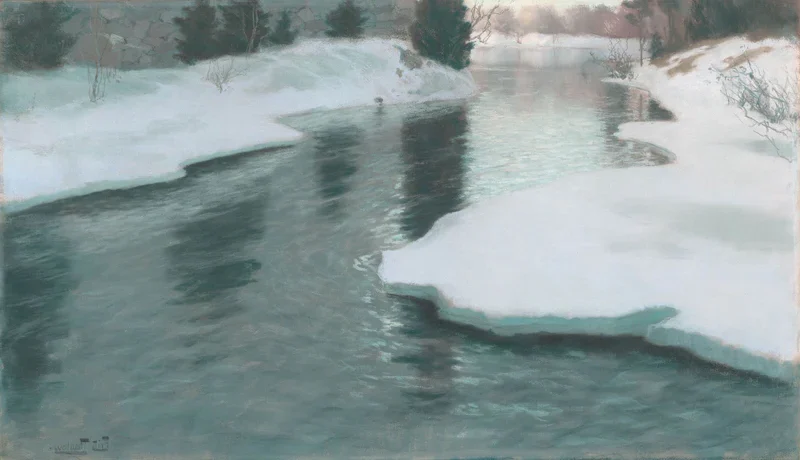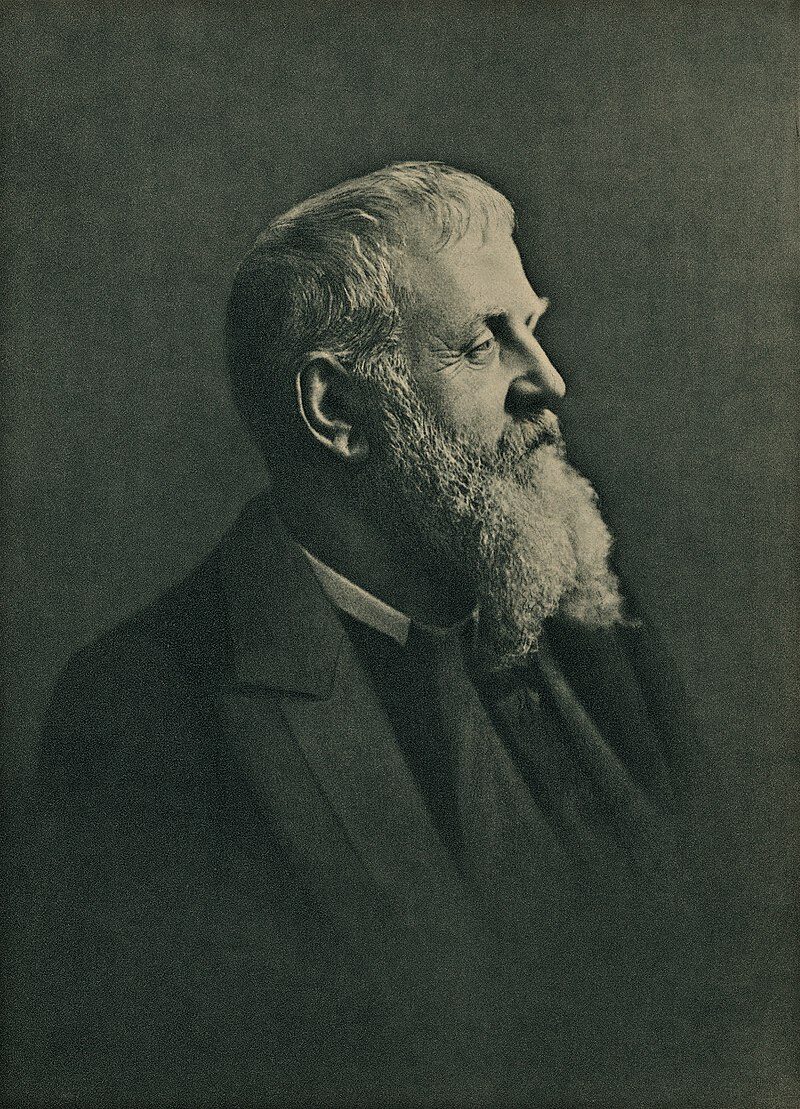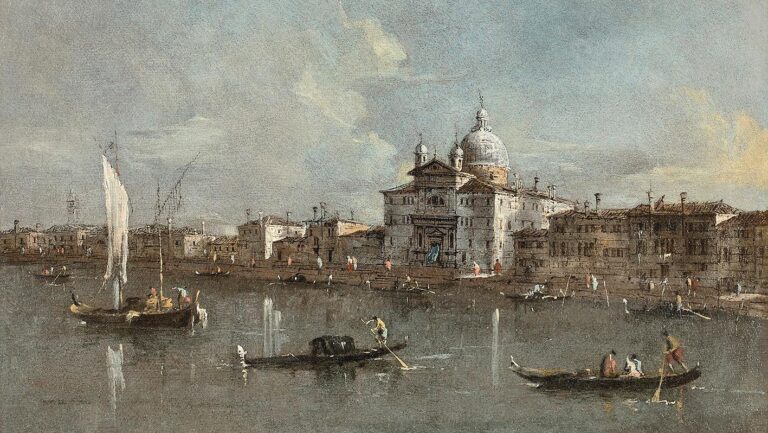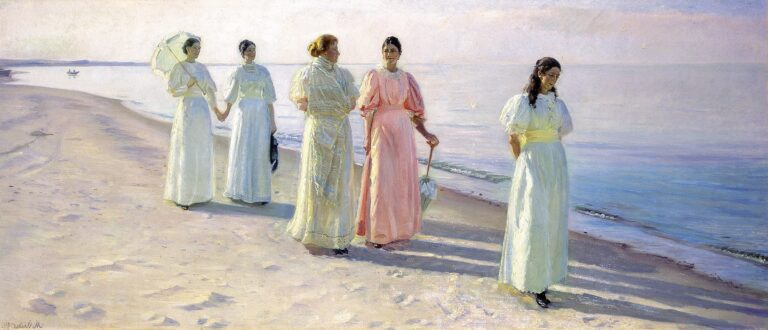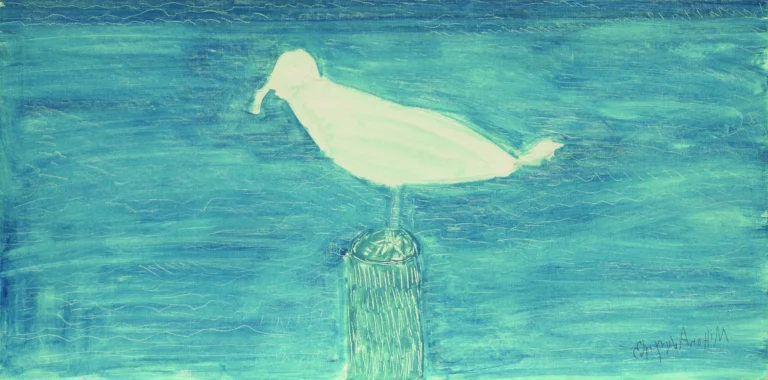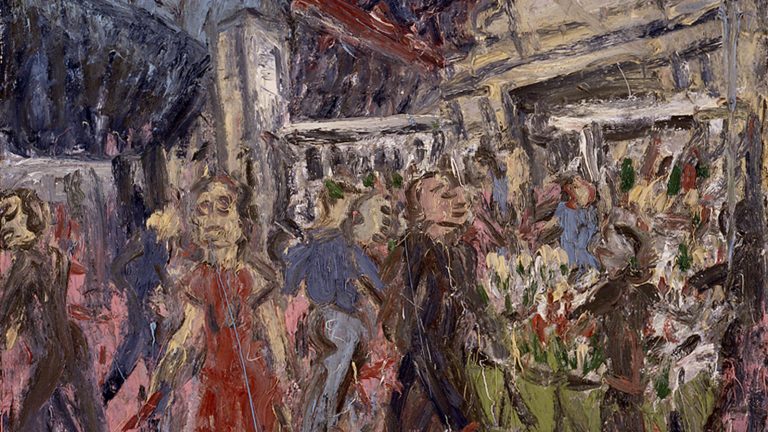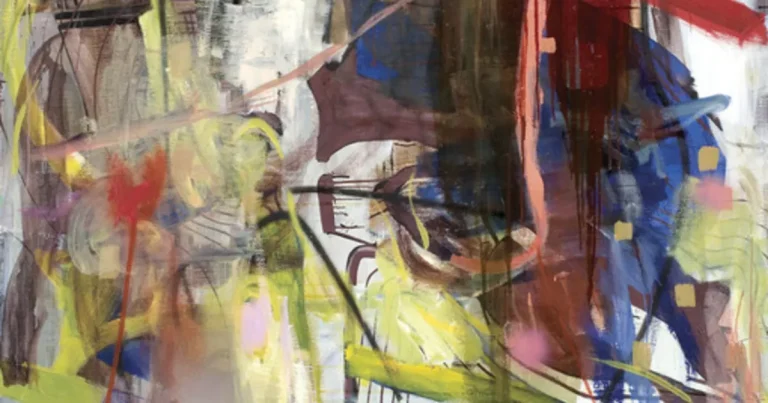Frits Thaulow: Painter of Impressionist River Landscapes
Born: 20 October 1847, Christiania, Norway
Death: 5 November 1906, Volendam, Netherlands
Mouvement artistique : Impressionnisme
Nationalité : Norvégien
Teacher: Hans Gude
Institution: Academy of Art, Copenhagen and Baden School of Art, Karlsruhe
Frits Thaulow: Painter of Impressionist River Landscapes
Life and Career of Fritz Thaulow
Frits Thaulow (1847-1906) developed from a young Norwegian art student into one of the most respected peintres paysagistes of his time. His journey took him from Christiania (now Oslo) to Paris, where he refined his distinctive style of capturing water reflections and winter scenes.
Petite enfance et éducation
Born on October 20, 1847, in Christiania (now Oslo), Norway, Frits Thaulow showed artistic talent at an early age. He made a firm decision to pursue art as his career and began formal training at the Royal Academy of Drawing in Oslo between 1862-1863.

The King, from Akershus Fortress, 1878 by Frits Thaulow
Thaulow continued his education at the Academy of Fine Art in Copenhagen from 1871-1874. During this formative period, he was initially drawn to marine painting, developing the keen eye for water that would later become his signature.
He was one of the earliest artists to visit and paint in Skagen, at the northern tip of Jutland, Denmark. This area would later become famous for its colony of Scandinavian artists known as the Skagen Painters.
Déménagement à Paris et développement artistique
In the 1880s, Thaulow relocated to Paris, a move that significantly influenced his artistic style. He became part of a growing community of Scandinavian landscape painters in the French capital.
During this period, he collaborated with Swedish painter Carl Skanberg and developed friendships with other artists. Paris exposed Thaulow to Impressionism, though he maintained his own distinctive approach to landscape painting.
His work evolved to focus on naturalistic depictions of landscapes, particularly winter scenes and reflections in water. These subjects became his specialty, and he developed remarkable technical skill in capturing the subtle play of light on water surfaces.
Later Years and Honors
As his reputation grew, Thaulow exhibited his works at the National Art Exhibit and other prestigious venues. His distinctive paintings of rivers, streams, and winter landscapes earned him international recognition.

On the Coast. Motif from Jaeren, Norway, 1879 by Frits Thaulow
For his contributions to art, Thaulow was awarded the Royal Norwegian Order of St. Olav. He also spent time in Volendam, Netherlands, where the local scenery and light provided new inspiration for his landscapes.
Despite his international career, Thaulow maintained strong connections to Norway. He continued painting prolifically until his death on November 5, 1906. His works are now highly valued for their technical brilliance and sensitive portrayal of natural environments, especially his masterful renderings of water.
Style artistique et influences
Fritz Thaulow developed a distinctive artistic approach that combined réalisme with impressionist techniques. His work is most recognized for masterful depictions of water and landscape scenes that captured both movement and light with exceptional detail.
Realism and Naturalistic Depictions
Thaulow firmly believed in realism as an artistic approach. He advocated that Norwegian artists should embrace this genre rather than purely romantic or stylized interpretations of nature. His paintings demonstrate a commitment to représentation naturaliste, particularly in his landscape works.

View of Amerikavej in Copenhagen, 1881 by Frits Thaulow
The artist’s most notable achievement was his ability to capture water realistically in various forms. His paintings show remarkable skill in depicting the movement and flow of rivers, streams, and coastal scenes.
Thaulow’s work stands out for its detailed observation of nature. He painted outdoor scenes with careful attention to light, texture, and environmental conditions. This naturalistic approach earned him recognition as one of history’s masters of landscape painting.
Influence of French Impressionists
Thaulow was significantly influenced by the French Impressionist movement during his time in Paris. He adapted their techniques while maintaining his distinctive style focused on realistic representation.
Unlike some impressionists who prioritized mood over detail, Thaulow combined impressionist brushwork with precise observation. This approach created dynamic paintings that maintained naturalistic accuracy while capturing atmospheric qualities.
The artist was part of the vanguard that promoted new approaches to landscape painting pioneered by French Realists. His work in Skagen, Denmark, also connected him to the famous Skagen Painters group, an important artistic community in Scandinavia.
Thaulow’s painting technique shows a delicate balance between impressionist light effects and detailed realism. This synthesis created his signature style that earned international recognition and influenced later generations of Nordic landscape painters.
Œuvres notables et héritage

Factories in Ivry, 1883 by Frits Thaulow
Fritz Thaulow created remarkable paintings that captured water scenes with exceptional detail and atmosphere. His works continue to influence artists and are displayed in prestigious museums worldwide.
Signature Paintings and Subjects
Thaulow’s most celebrated works showcase his mastery of depicting water surfaces. “A French River Landscape” demonstrates his ability to capture reflections and movement in water with incredible precision. Another significant painting, “Winter’s Day in Norway,” reveals his talent for portraying snow and ice-covered streams in his homeland.
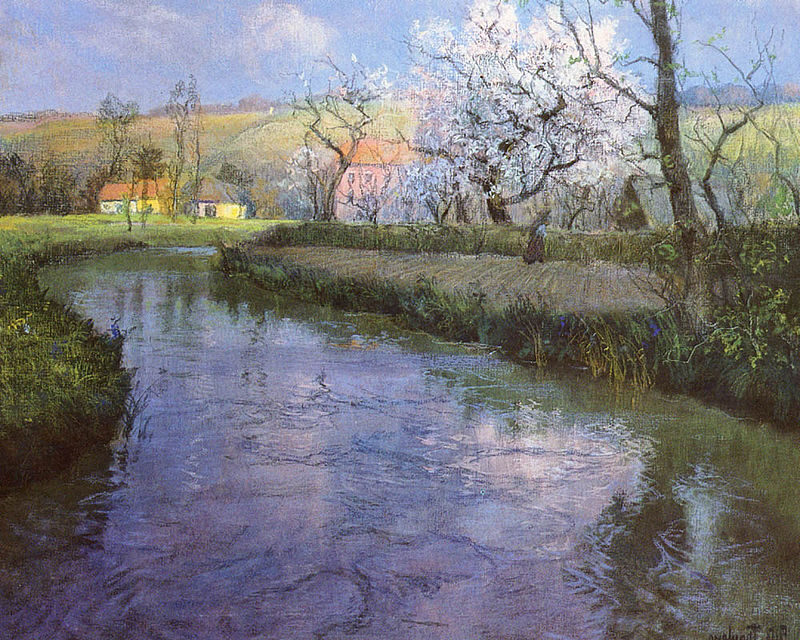
A French River Landscape by Frits Thaulow
“Venetian Backwater” stands among his finest achievements, displaying the unique quality of light in Venice and his trademark water reflections. Thaulow frequently painted scenes from Montreuil-Sur-Mer, Dieppe, and Quimperle in France, where he lived during various periods.
His technique of using thick, precise brushstrokes to depict flowing water became his artistic signature. Many critics consider his river scenes from Norway and France to be unparalleled in their atmospheric quality.
Collections et expositions
Thaulow’s works appear in several prestigious museums including:
- The Hermitage Museum in St. Petersburg
- Museum of Fine Arts in Boston
- National Gallery in Oslo
- Musée d’Orsay in Paris
During his lifetime, Thaulow’s paintings were regularly featured at the Høstutstillingen (Autumn Exhibition) in Norway, where they received critical acclaim. His work gained international recognition through exhibitions in Paris, London, and New York.
Today, high-quality art prints and reproductions of Thaulow’s paintings are sought after by collectors worldwide. Museum-quality reproductions offer various customization options for art enthusiasts who appreciate his unique style.
Impact et reconnaissance
Thaulow’s influence extended beyond his own artwork. As a Norwegian Impressionist painter, he helped bridge Scandinavian and French artistic traditions during a critical period in art history.

Winter at the River Simoa, 1883 by Frits Thaulow
His innovative approach to marine painting and landscape scenes inspired generations of artists who studied his techniques for capturing water reflections. Critics praised his ability to convey both tranquility and movement in natural settings.
Thaulow received numerous awards during his career, including medals at the Paris Salon. His friendship with Claude Monet and other prominent artists helped facilitate cultural exchange between Nordic and French artistic communities.
His legacy continues today through retrospective exhibitions that highlight his contribution to Impressionism and his unique position as a Nordic artist who successfully integrated international influences.
Questions fréquemment posées
Frits Thaulow, the Norwegian Impressionist painter, left a significant mark on histoire de l'art through his distinctive water landscapes and blend of realism and impressionism. His life and work continue to intrigue les amateurs d'art dans le monde entier.
What are the most notable works of Frits Thaulow?
Thaulow’s most celebrated works include “Picquigny,” a canvas showing the village near Amiens on the Somme river, which he painted during several weeks in late autumn 1899.
“Winter at Simoa River” captures his mastery of painting frozen water surfaces with remarkable detail and light effects.
“A Mill at Waterloo, Belgium” demonstrates his fascination with industrial landscapes integrated with natural water elements.
Where can one find Frits Thaulow paintings on exhibit?
The Philadelphia Museum of Art houses several important Thaulow works, making it a significant destination for those interested in his paintings.
The National Gallery in Oslo, Norway maintains a collection of his works in his native country.
The Musée d’Orsay in Paris occasionally exhibits his paintings, reflecting his connection to French art circles during his career.
What was Frits Thaulow’s contribution to the art world?
Thaulow pioneered a distinctive blend of realism and impressionism, creating a unique approach to landscape painting that emphasized water scenes with remarkable technical precision.
He was among the earliest artists to paint in Skagen in northern Jutland, contributing to the foundation of what would become the famous Skagen Painters movement.
His work bridged Norwegian and French artistic traditions, fostering international exchange of painting techniques and styles.
Who was Else Frölich in relation to Frits Thaulow?
Else Frölich became Thaulow’s second wife after his first marriage ended. Their relationship caused some controversy in Norwegian society at the time.
She appeared in several paintings by other artists of the period, including some by members of the Skagen group.
After marrying Thaulow, she accompanied him during his travels through Europe, supporting his artistic career.
What is the historical significance of ‘At Quimperlé’ painted by Frits Thaulow?
‘At Quimperlé’ represents Thaulow’s time in Brittany, France, where he painted numerous scenes capturing the region’s distinctive architecture and waterways.
The painting demonstrates his maîtrise technique in depicting reflections on water surfaces, a skill for which he became renowned.
Art historians consider this work important for showing how Thaulow adapted French impressionist techniques while maintaining his distinctive Norwegian sensibilities.
How has Frits Thaulow’s style influenced modern landscape painting?
Thaulow’s careful attention to water’s reflective qualities and movement has influenced generations of landscape painters. They study his technical approach.
His balanced combination of impressionist color theory with detailed realism created a pathway for artists seeking to move beyond strict categorization.
Contemporary painters of winter scenes and water landscapes often reference Thaulow’s methods for capturing light on snow and ripples in water, demonstrating his enduring relevance.

